Digital Microscopes
Observation and Analysis of Plating Defects
In order to achieve high-quality assurance for plating, thorough observation and visual inspection is required. This section introduces typical plating defects and explains the symptoms and causes of these defects.
This section also introduces examples of overcoming common defect inspection problems using KEYENCE's latest 4K digital microscope.
Types and Causes of Plating Defects

Plating is frequently used to process surfaces of various shapes and materials including metal, plastic, and ceramics. Covering surfaces with a coating not only adds ornamental effects, but can also change the physical characteristics of the surface, such as improving wear, heat or corrosion resistance, making a surface electrically conductive, or increasing adhesion. Any plating defects that occur during the process can greatly affect the quality and characteristics of the finished product.
The following are three major types of plating defects that occur, their symptoms, and their causes.
Insufficient adhesion: Peeling, blister
When the adhesion to the substrate is reduced, the plating fails to firmly stick to the surface and can blister or peel when formed in post-processing due to differences in the flexibility of the substrate and the plating.
Defects due to foreign particle adhesion: Rough surface
This symptom can be seen when fine protrusions are generated on plating surfaces in wet plating. This symptom occurs when foreign particles floating in the plating bath are mixed into the plating layer.
Deposit missing: Stain, unevenness, pit, pin hole
Most inconsistencies on plating surfaces occur when the surfaces are partially tarnished. These symptoms are typically caused by uneven surface roughness or insufficient degreasing on the surface.
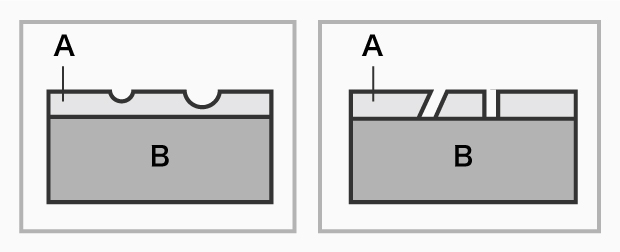
Left: pit, right: pin hole
(A. plating layer, B. base material)
Both pits and pin holes are concave defects on plated surfaces. They are caused by deposit missing. A pit is a visible (macroscopic) hole that does not penetrate a plating layer, while a pin hole is a micropore that penetrates into a base material or a lower layer. Pin holes can cause secondary failures and defects such as “blistering” and “corrosion” of plating layers.
To accurately determine whether a defect is a pit or a pin hole, height data (layer thickness and hole depth) is required in addition to 2D images.
Get detailed information on our products by downloading our catalog.
View Catalog

Inspection Examples of Plating Defects Using the 4K Digital Microscope
Plating greatly affects product functionality, performance, and durability as well as appearance. In recent years, plating has achieved a higher level of functionality, requiring more advanced defect analysis and reliability evaluation.
Plating layers are thin and reflective, and typical defects that occur are microscopic and three-dimensional. Inspections using conventional measuring instruments or 2D images have various problems when it comes to ensuring reliable plating quality.
KEYENCE's VHX Series high-definition 4K Digital Microscope uses a high-resolution HR lens and cutting edge technologies such as a 4K CMOS, enabling accurate observation and analysis of plating layers with clear 4K images.
The VHX Series also supports 2D measurement and 3D shape and profile measurement, making it possible to complete quality control inspections easily and quickly with a single unit.
This section introduces the latest inspection examples of plating defects using the VHX Series.
Discoloration and corrosion in plating
Observation and measurement of discoloration and corrosion of the plating using the VHX Series 4K Digital Microscope

Plated connector (200x)

Plated connector (1500x)
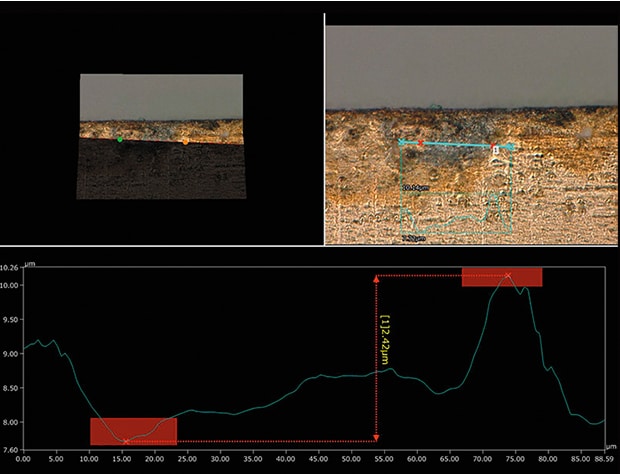
3D shape and profile measurement (1500x)
Pin hole on plating layers
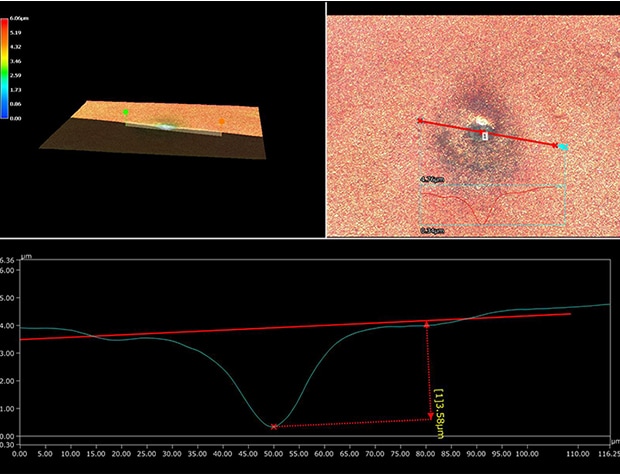
3D shape and profile measurement on a pin hole
Measurement of a pin hole on a plating layer using the VHX Series 4K Digital Microscope
Peeling of plating
Inspection of microscopic peeling using the VHX Series 4K Digital Microscope

High-magnification observation and submicron measurement enabled with high-resolution 4K images
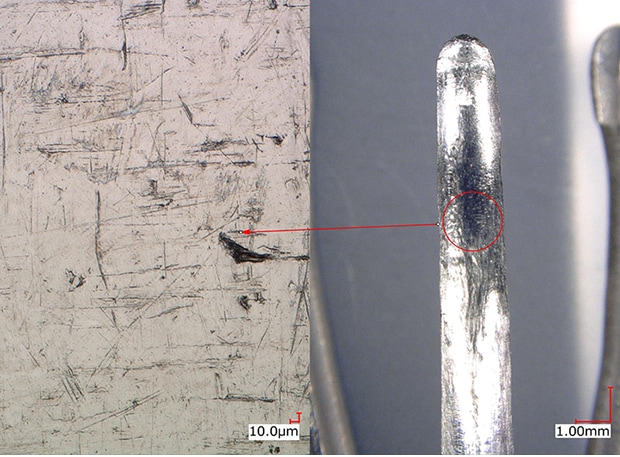
High-magnification observation of peeling on an endoscope part
Cracks in plating
HDR imaging of cracks using the VHX Series 4K Digital Microscope

Normal
The HDR imaging function and depth composition enable fully focused imaging with high color gradation and contrast.

HDR and depth composition image
Analysis of rough surfaces (adhesion of foreign particles)

High-magnification observation and measurement of foreign particles causing a rough surface
Analysis of foreign particles using the VHX Series 4K Digital Microscope
Thickness measurement of plating layers

Cross-section measurement of plating
Plating thickness using the VHX Series 4K Digital Microscope
We’re here to provide you with more details.
Reach out today!

Examples of Problems in Plating Inspections Solved with KEYENCE’s 4K Digital Microscope
Magnified observation, defect analysis, and measurement are difficult on plated surfaces, and thus appearance inspections using conventional microscopes or measuring instruments have many problems.
This section introduces examples of problems in plating inspections solved with the VHX Series, KEYENCE’s latest 4K Digital Microscope.
Clear imaging of plating surfaces even at high magnification
Conventional problems with microscopes
Plated surfaces have irregularities, which makes it difficult to focus on the surfaces and increases the number of steps in high-magnification observation. Insufficient resolution can also hinder accurate evaluation.
With the VHX Series 4K Digital Microscope
The high-resolution HR lens and 4K CMOS provide a larger depth of field even in high-magnification observation. Fully focused clear observation that is not affected by irregularities on plated surfaces is possible even at high magnification.

Gold-plated surface (1000x)
Observation of a plated surface using the VHX Series 4K Digital Microscope
Fully-focused imaging and effortless zooming
Conventional problems with microscopes
At higher magnifications, the area in focus becomes smaller. When working with irregular surfaces, this causes time-consuming adjustments to be made, or a different lens may need to be used, significantly increasing the time required to inspect the surface.
With the VHX Series 4K Digital Microscope
Real-time depth composition enables users to instantly capture fully-focused images of targets that have surface irregularities. This reduces the time required and makes it possible to quickly observe the entire target, providing more effective analysis and evaluation.
Observation of plating using the depth composition of the VHX Series 4K Digital Microscope

Conventional microscope

VHX Series depth composition
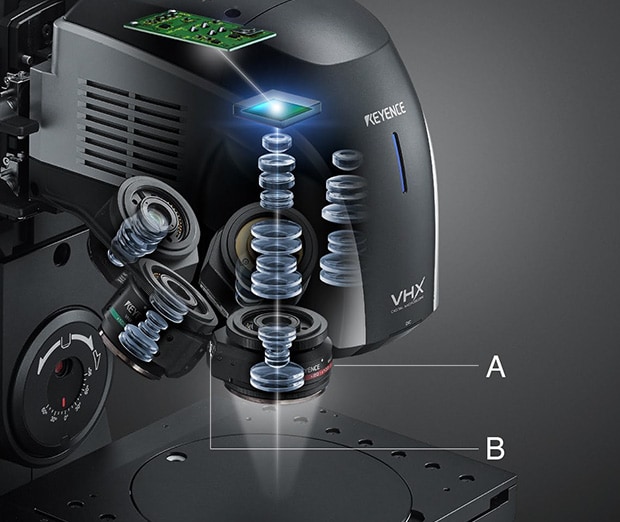
A. High-resolution HR lens B. Motorized revolver
Furthermore, the high-resolution HR lens and motorized revolver mounted on the VHX Series enable seamless zoom between 20x and 6000x without lens replacement.
The lens automatically changes according to the magnification required, enabling quick zooming. Efficient data management is also possible because the information of the lens and magnification is recorded with the captured image.
3D shape and profile measurement
Conventional problems with microscopes
Microscopes do not capture the information of the Z axis (height/depth) and thus cannot detect or measure 3D defects. A separate 3D measuring instrument must be used, increasing the number of man-hours required.
With the VHX Series 4K Digital Microscope
With 3D shape and profile measurement, targets can be examined quantitatively to determine whether a defect is a foreign particle, dent, pit, or pinhole. Operations from magnified observation to 2D/3D measurement can be performed effectively with a single VHX Series unit.

3D shape and profile measurement of a rough plating surface
Observation of a plated surface using the VHX Series 4K Digital Microscope
Quantitative evaluation with automatic area measurement
Conventional problems with microscopes
Quantitative evaluation and crystal counting is impossible. A dedicated measuring instrument or software is required, again increasing the number of inspection steps required.
With the VHX Series 4K Digital Microscope
The automatic measurement function easily measures the area, crystal grain size, and number of grains in a specified region. In addition, the number of particles and their sizes can be displayed in tables, histograms, or output to a report.

Measurement of the amount of corrosion on the plating (150x)
Automatic area measurement using the VHX Series 4K Digital Microscope

Crystals (100x)

Binary processing (table and histogram of measurement results)
Visual inspection of appearance
Conventional problems with microscopes
Conventional microscopes cannot analyze and evaluate images captured under different lighting conditions in real-time, and also cannot quickly reproduce previously used lighting conditions.
With the VHX Series 4K Digital Microscope
The multi-lighting function allows users to instantly capture and compare images under various lighting conditions and provides effective evaluation of plated surfaces that look different depending on the lighting.

A. Coaxial illumination B. Ring illumination C. Coaxial partial illumination D. Mixed illumination
Appearance comparison under different lighting conditions using the VHX Series 4K Digital Microscope
We’re here to provide you with more details.
Reach out today!

A Single Unit Provides Streamlined Inspection and Evaluation
KEYENCE's VHX Series high-definition 4K Digital Microscope uses clear 4K images to significantly streamline observation, analysis, and quantitative evaluation of plating defects—which are difficult with conventional microscopes. It also enables previously impossible 2D/3D measurement, binary measurement, and report creation seamlessly in a single unit.
For additional product info or inquiries, click the buttons below.
Get detailed information on our products by downloading our catalog.
View Catalog




